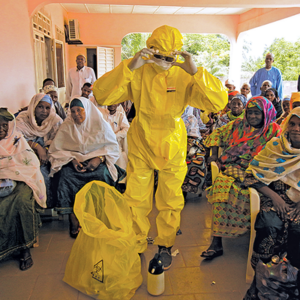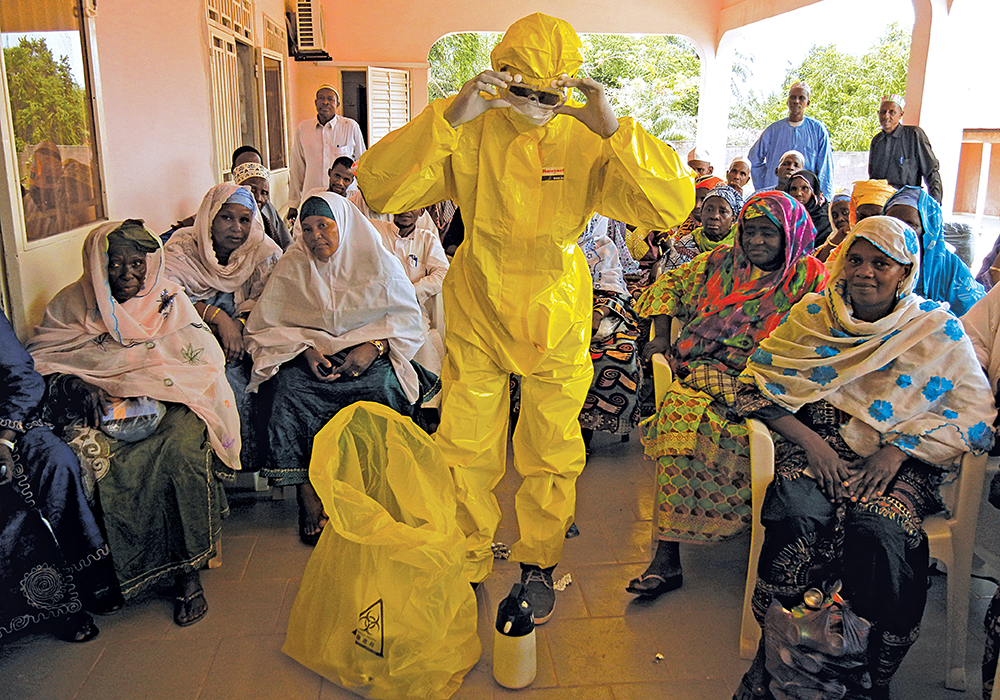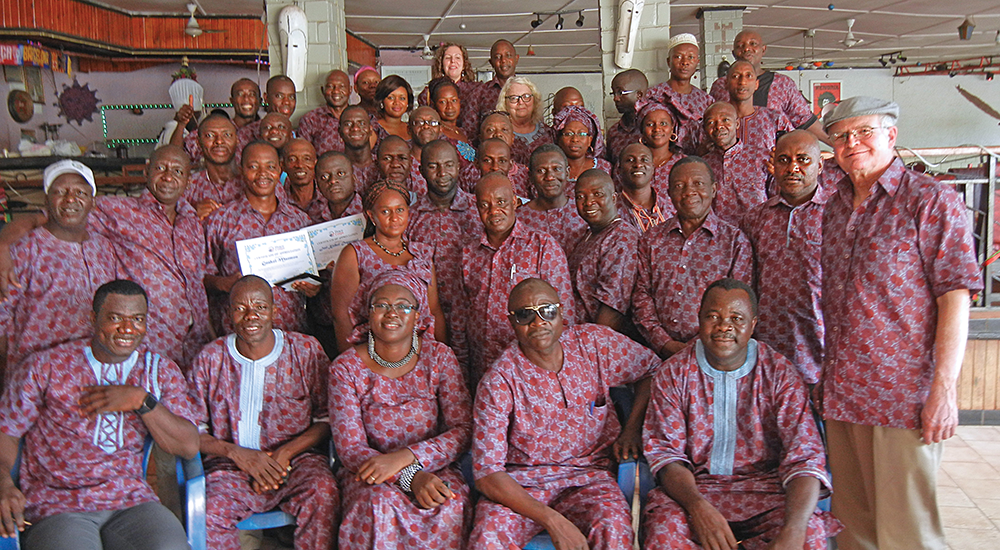 Peace Corps’ untold story of fighting the virus in Guinea
Peace Corps’ untold story of fighting the virus in Guinea
By Douglass P. Teschner
This story first appeared in the Summer 2019 edition of WorldView magazine. We bring it to you here as we battle another pandemic.
In West Africa between December 2013 and June 2016, there were 28,616 known cases of the Ebola virus and 11,310 deaths. 3,804 of those cases and 2,536 deaths were in Guinea, where I was Peace Corps country director. But there would have been many more if it hadn’t been for the work of Peace Corps staff and RPCVs. When the epidemic was finally contained, the U.S. Ambassador to Guinea, Dennis Hankins, wrote, “Peace Corps local staff were able to make a key contribution in fighting Ebola. Through their collective efforts, I am convinced hundreds if not thousands of lives were saved.”
‘Who will help Guinea?’
The very contagious and deadly virus first appeared in Guinea in December 2013 and soon spread to Liberia and Sierra Leone. When it became clear that the disease would not be easily contained, Peace Corps evacuated more than 300 Volunteers from the three countries in August of 2014. As the Guinea country director, I asked each of the 97 evacuating PCVs to write on post-it notes their parting thoughts about Guinea: “Family,” “My Home,” and “Love” were typical responses. One Volunteer asked painful questions in her award-winning blog: Who will help Guinea? Who will be their hero?
Within a month Peace Corps Director Carrie Hessler-Radelet and Thomas Frieden, the director of the Centers for Disease Control and Prevention, signed an interagency agreement to use Peace Corps motor pool, offices, and staff to support the growing CDC mission in West Africa. That agreement included drivers and staff acting as translators and guides for CDC health workers. In Guinea, we initially hosted 10 CDC infection control training events for health care workers. Together with RPCVs working at CDC, Peace Corps Guinea staff saw an opportunity for even greater impact given Peace Corps’ training expertise, national network, deep history and knowledge of the culture.
A key part of eradicating Ebola was contact tracing: identifying every person who had been in close contact with those infected, followed by daily checks for 21 days to ensure that they did not become ill or spread the disease to others.
A key part of eradicating Ebola was contact tracing: identifying every person who had been in close contact with those infected, followed by daily checks for 21 days to ensure that they did not become ill or spread the disease to others. There were, however, many rumors and widespread resistance; many of those who had contact with Ebola went into hiding, and there were incidents of crowds attacking government convoys.

A Red Cross worker shows how to dress in body suits to work among infected populations. Photo by Douglass Teschner
Grassroots Community Education
We designed a four-phase cascading training-of-trainers approach. CDC trained 25 Peace Corps staff and trainers as master trainers. Peace Corps staff recruited homemakers, teachers, students, NGO workers, youth leaders, and community leaders in all parts of the country to become community educators. Our 25 master trainers conducted 26 workshops for these 995 people.
“We believe that this grassroots approach may be the key to ultimately gaining the cooperation we so desperately need.”
Each training included discussion of common rumors and how to overcome fear and resistance, including role plays using UNICEF picture books. Ebola survivors shared their experiences facing stigmatization. A CDC epidemiologist said, “We were so impressed with the training. Community acceptance and cooperation are so critical to stopping transmission, and we believe that this grassroots approach may be the key to ultimately gaining the cooperation we so desperately need.”
Each community educator developed a personal action plan starting with family members and people they knew and reported that without any resistance they taught 295,612 people about the virus. “They accept us because we are from the community,” said one of our educators. “They don’t trust people coming in a car.” We estimate that this initiative reached 3.2 million people all told, one quarter of Guinea’s population.
Called on to act
The commitment of our trained community educators went beyond simply teaching. In the town of Dubreka, a truck hit and killed two young motorbike taxi drivers and the Red Cross arrived to bury the bodies, a standard practice during the Ebola crisis. When a gathering crowd of young people saw their dead friends being placed in plastic body bags, they threatened to burn down the hospital.
Two of our community educators talked to the angry youths about why all burials needed to be secure. “Let’s protect ourselves, families and others,” they explained. By stepping forward they defused the crisis and escorted the Red Cross to the cemetery to ensure that the bodies were respectfully buried, and that the crowd remained peaceful.
When a local politician told villagers that the virus was only a rumor spread by the ruling party to delay elections, an educator convinced the crowd it was, in fact, a deadly and contagious virus.
Among their many acts of public service in the face of personal risk, our community educators discovered people who were hiding and persuaded them to seek treatment. They discovered others who tested positive, were treated and cured. A young trainer discovered a sick man in a taxi and took him to a health center where a nurse found that the man had died. He was safely removed. Another persuaded a family to test their dead daughter and, when tested positive, she was safely buried and the family agreed to follow up contact for 21 days. When a local politician told villagers that the virus was only a rumor spread by the ruling party to delay elections, an educator convinced the crowd it was, in fact, a deadly and contagious virus. Another educator persuaded a frightened community to let their school re-open and was invited to hold Ebola awareness classes.
Washing bodies, tracing the virus
Those who faced the greatest risk were those who came in close contact with victims: family members, health care workers, and the people who washed the bodies of the dead, a deep cultural tradition in Guinea that proved to be a source of many infections. In collaboration with the Red Cross, our Peace Corps staff conducted 38 trainings for Muslim imams and body washers who trained 2,798 people in local languages. The lead imam in Dubreka told U.S. Ambassador Alex Laskaris that this training was the best he had ever received.
Our Ebola training initiative succeeded for many reasons. We identified respected community members to volunteer as community educators. These community educators gained credibility, earned respect and gained trust as unpaid educators. They asked open-ended questions and did not judge people who were skeptical or who had heard false rumors. They applied participative approaches to learning, used their local languages and adapted messages to the community level. They were trained with role-playing techniques that helped them communicate effectively.
Peace Corps Guinea staff played a major role in other efforts to contain the epidemic. We collaborated with CDC and the World Health Organization (WHO) on training 361 contact-tracing team health workers to use the most effective communication skills to negotiate positive citizen cooperation. Our language trainers worked with the U.S. embassy and Carnegie Mellon University to translate key Ebola messages into local languages for mass distribution via cell phone. We assisted the government of Guinea, the Red Cross and WHO to pilot training of a rapid diagnostic test to be administered by Red Cross staff and other health workers.

The Peace Corps Guinea staff and Doug Teschner (standing, far right) celebrated their Ebola Community Education success after 17 months battling the often-fatal 2014 virus. Photo courtesy Douglass Teschner
RPCVs Matter
As we know, Returned Peace Corps Volunteers make a vital difference long after their service as PCVs, and this was never more true than during the Ebola response. CDC sent many people to each of the three countries, including RPCVs who had served in rural villages in Guinea and other francophone African countries. Seven who played a key role supporting our efforts were Molly Gaines-McGollom, Dana Schneider, Angela Thompson-Paul, Ben Dahl, Peter Kilmarx, James Ham, and Hermence Matsotsa. CDC also hired five of our own evacuated Volunteers for their language and cross-cultural skills. Other RPCVs contributed to the Ebola response through their work with the State Department, USAID, and NGOs.
Back in the United States, our evacuated Volunteers fundraised with NPCA and sold T-shirts to support Guinea NGOs. When family packages arrived in Guinea after the evacuation, PCVs we contacted asked that the toiletries, clothes, and food be donated to Ebola survivors.
By the fall of 2015, the epidemic was in retreat. A new vaccine was being used, local cooperation increased, and the number of cases fell dramatically.
By the fall of 2015, the epidemic was in retreat. A new vaccine was being used, local cooperation increased, and the number of cases fell dramatically.
”I’m so proud of our outstanding, amazing, extraordinary staff in Guinea,” Peace Corps Director Hessler-Radelet wrote to our staff. “What heroes you all are! It’s such a privilege to call you our own … You are saving many lives and your work could not have a higher calling.” Peace Corps sent a cash award to the whole Guinea staff, and we bought a large quantity of pagna, traditional fabric. Each staff member was given a piece and, as is the tradition in Africa, asked local tailors to make us each a shirt or dress. Then we went out to lunch at a Conakry restaurant in our matching outfits! Mr. Fode Tass Sylla, communication coordinator for the Guinea National Ebola Coordination Committee, came to express his gratitude for the way Peace Corps operated in Guinea.
Ending Ebola
On December 29, 2015, WHO declared Guinea free of Ebola free (although a few isolated cases later popped up in 2016). On January 5, the first 15 Peace Corps Volunteers returned to Guinea: seven Response Volunteers (five of whom had been evacuated 17 months previously) and eight Volunteers transferred from recently evacuated Mali.
We held an emotional welcome back ceremony with our new ambassador, Dennis Hankins. We had left on the walls the post-it notes written by the PCVs evacuated 17 months earlier. I asked the five returnees to take down their post-it notes and read aloud what they had written. Staff and new PCVs were then asked to pick one that had meaning to them. I chose one — labeled “Home.” I had been in country less than three weeks when the evacuation order came, but Guinea had become my home.
“One day soon Ebola will be a part of Guinea’s history, not its reality. And when that day comes, I hope people will remember the part that the Peace Corps played.”
More than Ebola
The work we did had far more impact than helping to end the epidemic. At one of the community education trainings, a host country national enthusiastically told the group, “This training is about more than Ebola, Peace Corps trains us to improve ourselves.” When a local radio station asked two of our community educators where they had received this great training to fight the Ebola virus, one of them answered, “Peace Corps.” And both of them smiled with pride and joy.
A key to our success during the epidemic was Ousmane Diallo, Peace Corps Guinea’s deputy director of programming and training. He wrote, “One day soon Ebola will be a part of Guinea’s history, not its reality. And when that day comes, I hope people will remember the part that the Peace Corps played: that at a time of so much tragedy and so much need, our Peace Corps staff stayed, and stood true to our partnership with the people of Guinea.”
You can read this story and more than a decade’s worth of WorldView archives in the WorldView app. Sign up and download it here.
Dr. Douglass Teschner served in Morocco 1971–73 and was Peace Corps country director in Burkina Faso, Ukraine, and Guinea. He trains and coaches effective leadership. See www.GrowingLeadershipLLC.com.